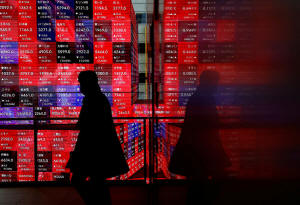Stocks trampled, Nikkei tumbles past Black Monday milestone
 Send a link to a friend
Send a link to a friend
 [August 05, 2024] By
Nell Mackenzie and Wayne Cole [August 05, 2024] By
Nell Mackenzie and Wayne Cole
LONDON/SYDNEY (Reuters) - Wall Street looked to follow a global stock
rout with Japanese shares at one point exceeding their 1987 "Black
Monday" loss, as fears of a U.S. recession sent investors fleeing from
risk while wagering that rate cuts would be needed to rescue growth.
Nasdaq futures fell over 4% while S&P 500 futures fell around 3% ahead
of the U.S. open following a stock sell-off that started in Japan and
spread a sea of red across European markets.
CBOE's volatility index, known as Wall Street's fear gauge, tracking
market turmoil, jumped over 30 points to 53.55, the highest level since
March 31, 2020.
Japan's benchmark Nikkei average closed 12.40% lower at 31,458.42, its
largest one-day fall since October 1987, while the broader Topix lost
12.48% to 2,220.91.
"There are lots of other big moves in markets but it's safe to say they
wouldn't have been nearly as big if it wasn't August," said Jim Reid,
global head of macro and thematic research, pointing to how
thinly-traded summer markets can be roiled more easily.
The moves were grounded in reality, said Reid, pointing to the fact that
the holdout dove Bank of Japan was finally in a hiking cycle for the
first time in two decades, as well as to elevated tech valuations and
positioning, and a soft U.S. payrolls report on Friday.
European shares fell to near six-month lows, with only a handful of
stocks trading in the green.

The pan-European STOXX 600 index was down about 3% at 483.17 points, its
lowest since Feb. 13.
Germany's DAX, France's CAC 40, Britain's FTSE and Spain's IBEX 35 all
fell more than 2%.
The safe-haven yen and Swiss franc surged, as crowded carry trades
unravelled, sparking speculation that some investors were unloading
profitable trades to get money to cover losses elsewhere. Such was the
torrent of selling that circuit breakers were triggered on stock
exchanges across Asia. [FRX/]
Treasury bonds were in demand, with U.S. 10-year yields last down at
3.721%, the lowest since mid-2023.
A worryingly weak July payrolls report on Friday saw markets price in a
78% chance the Federal Reserve will not only cut rates in September, but
ease by 50 basis points. Futures imply 122 basis points of cuts in the
5.25-5.5% funds rate this year, and rates of around 3.0% by the end of
2025.
"Signs of emerging weakness in the U.S. economy are evident, with
negative indicators from hiring, retail sales, and PMI reports," said
Bruno Schneller, managing partner at Erlen Capital Management.
Schneller noted, however, that economic data like GDP and trade remained
stable while the prospect of autumn U.S. rate cuts approached.
Analysts at Goldman Sachs also noted the Fed's ability to re-instil
market optimism, estimating a 25% likelihood of a U.S. recession whereas
JPMorgan analysts were more bearish, assigning a 50% probability to a
recession.

[to top of second column] |

A visitor walks past Japan's Nikkei stock prices quotation board
inside a building in Tokyo, Japan February 19, 2024. REUTERS/Issei
Kato

"Now that the Fed looks to be materially behind the curve, we expect
a 50 bp cut at the September meeting, followed by another 50 bp cut
in November," said economist Michael Feroli.
SEEKING SAFE HARBOURS
Investors will get a read on employment in the service sector from
the ISM non-manufacturing survey later on Monday and analysts are
expecting a rebound to 51.0 after June's unexpected slide to 48.8.
This week has earnings from industrial bellwether Caterpillar and
media giant Walt Disney, which will give more insight into the state
of the consumer and manufacturing. Also reporting are healthcare
heavyweights such as weight-loss drugmaker Eli Lilly.
The huge drop in Treasury yields also overshadowed the U.S. dollar's
usual safe-haven appeal and dragged the greenback down 0.5% against
a basket of other major currencies.
The dollar fell by as much as 3.28% against the Japanese yen to
141.675 but had recovered to 142.675 by 1142 GMT, while the euro
dived 2.3% to 156.20 yen. The single currency rose against the
dollar to $1.0952. [USD/]
The Swiss franc was a major beneficiary of the rush from risk, with
the dollar falling around 1% and hovering at six-month lows of
0.8500 francs.
"The shift in expected interest rate differentials against the U.S.
has outweighed the deterioration in risk sentiment," said Jonas
Goltermann, deputy chief markets economist at Capital Economics.
"If the recession narrative takes hold in earnest, we would expect
that to change, and the dollar to rebound as safe-haven demand
becomes the dominant driver in currency markets."
Investors have also increased wagers other major central banks will
ease more aggressively, with the European Central Bank now seen
cutting by 67 basis points by Christmas.

In commodity markets, gold lost some of its safe haven appeal, down
around 2.3% at $2,387 an ounce. [GOL/]
Oil prices eased as concerns about global energy demand offset
worries about the potential impact to supply from a widening
conflict in the Middle East. [O/R]
Brent fell 123 cents to $75.58 a barrel, while U.S. crude lost 135
cents to $72.15 per barrel.
(Reporting by Nell Mackenzie and Wayne Cole; Editing by Christina
Fincher and Mark Potter)
[© 2024 Thomson Reuters. All rights
reserved.]
This material may not be published,
broadcast, rewritten or redistributed.
Thompson Reuters is solely responsible for this content. |